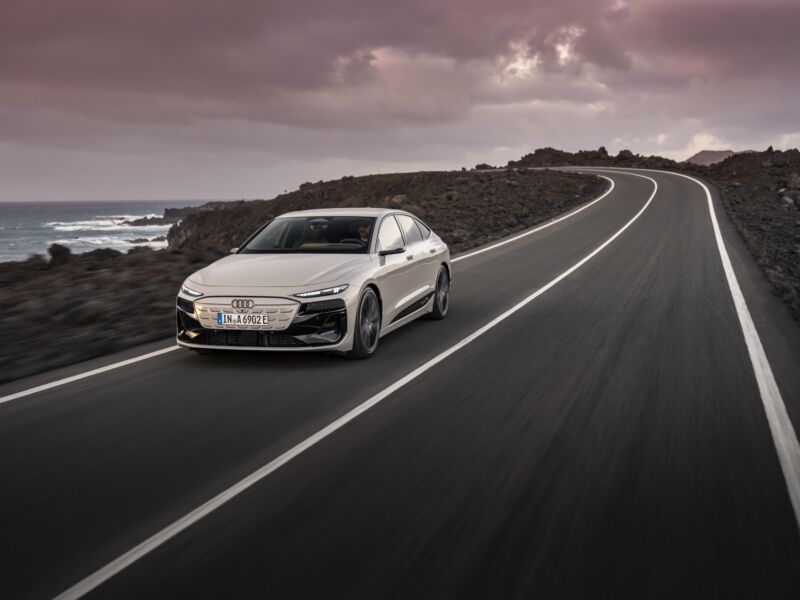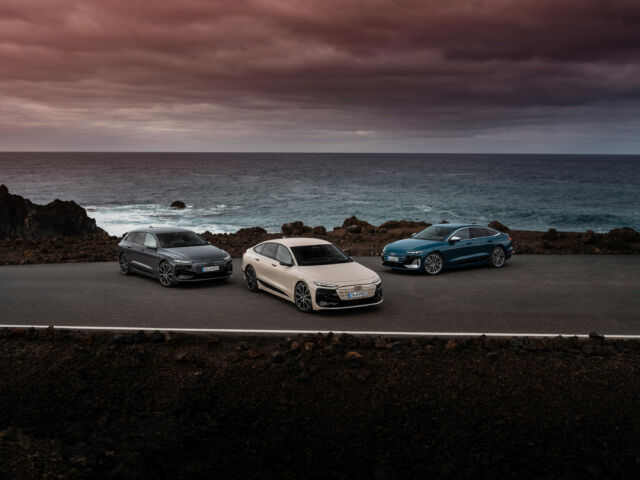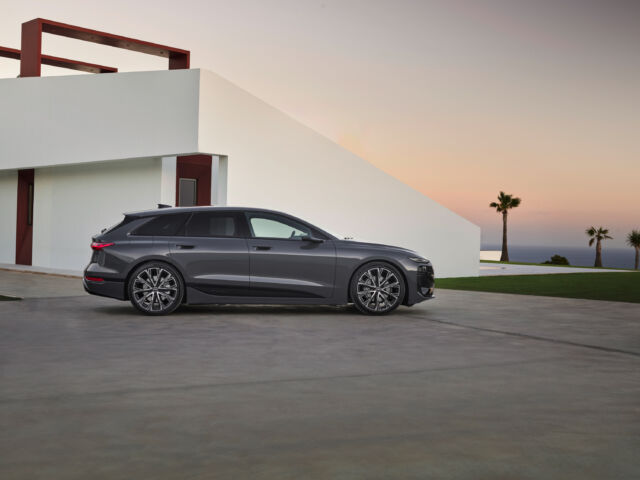

Audi
MUNICH—The sedan is not quite dead—at least not yet. While it’s true that car buyers are voting with their wallets and opting for crossovers and SUVs, not every automaker has given up on the form factor, even when it comes to electric vehicles. For example, Audi’s next EV will be the new A6 e-tron, which goes on sale in the US next year.
The pedants might quibble with calling the A6 e-tron a sedan, as the one we’re getting here is a midsize five-door, meaning it has a rear hatch instead of a trunk. In Audi lingo, that means it’s an A6 Sportback e-tron, with more of a two-box rather than three-box shape like the outgoing (internal combustion engine-powered) A6. Not that that’s a bad thing in our eyes—the rear hatch will make it easier to load or unload larger items (like a bicycle) into the cargo area.
“We were determined to give the A6 e-tron the attractive proportions of the concept car,” said Audi designer Wolf Seebers. “I’m talking about the classic Sportback silhouette that Audi fans are familiar with,” Seebers said.
-
Five-door fastbacks might be the best of all worlds.
Audi -
The A6 e-tron is remarkably low-drag.
Audi -
the side of the A6 e-tron does a good job of masking its height.
Audi -
The S6 e-tron is the sportier version.
Audi -
Sadly this cool fabric trim won’t be an option for US cars either.
Audi -
The A6 e-tron’s back seat manages to deliver footroom.
Audi -
The Audi logo at the back is illuminated.
Audi -
Side-view cameras cut drag slightly, but contravene the federal motor vehicle safety standards.
-
As long as the car detects the key within close proximity, you can use a foot gesture to open the frunk.
Audi -
Here’s the rear cargo area.
Audi -
An electrochromic roof is an option.
Audi
Getting that silhouette wasn’t especially easy. One reason that automakers and their designers have gravitated away from sedans as they make EVs is that it’s a lot easier to package a slab of lithium-ion batteries between the axles when you have the extra height of a crossover or SUV to play with.
For the Porsche Taycan (and Audi e-tron GT, built on the same J1 platform), that meant laying out the battery so there were voids that created space for the rear passengers to put their feet, wonderfully translated from the German as “foot garages.”
The 100 kWh battery (94.4 kWh usable) in the A6 e-tron has no foot garages despite its lower floor, but sitting in the back I found adequate room for my lower extremities as opposed to sitting so my knees were level with my chest. That’s because the A6 e-tron is actually a bit taller than Seebers and his colleagues would have liked otherwise. “We developed the inlay in the rocker panel to introduce a horizontal cut to the car, adding another segment to the side profile to visually compensate for the additional height,” he said.
It’s a very slippery shape
Whether or not you like the shape, it’s hard not to be impressed with how aerodynamically efficient it is. The drag coefficient is just 0.21, or at least it is if the A6 e-tron is fitted with side view cameras. These aren’t legal on US roads, so they won’t be offered here, and we’re not missing out—as with the original Audi e-tron, the location of the screens is not ideal, and fitting conventional reflective glass side mirrors only increases the Cd to 0.22. And that’s with wheels that range from 19–21 inches, no less.

Audi
The US will get three versions of the A6 when it goes on sale next year in either late spring or early summer. There’s a 362 hp (270 kW) rear-wheel drive A6 Sportback e-tron, a 422 hp (315 kW) all-wheel drive A6 Sportback e-tron quattro, and a 496 hp (370 kW) S6 Sportback e-tron, which is also all-wheel drive and which can increase its output to 543 hp (405 kW) for short bursts using launch control.
Like the Q6 e-tron we drove recently (which is also built using PPE), the battery pack runs at 800 V and so can DC fast charge at rates of up to 270 kW, which should take the pack from 10–80 percent state of charge in just 21 minutes. But we won’t have EPA range estimates until closer to the car arriving here next year.
No Avant for America
What we probably won’t get here in the US is the A6 Avant e-tron, which is the station wagon version. Audi has no plans to import either A6 Avant e-tron or S6 Avant e-tron, because if the Venn diagram of people who say they love station wagons and people who buy new Audis intersects, the overlap is very small. The automaker may be a bit more willing to consider the idea when the RS6 e-tron arrives in a couple of years—start your letter-writing campaign now if that’s a thing you want to see happen.
Much of the rest of the A6 e-tron’s details are very similar to the Q6 e-tron. The cabin layout is very familiar, although you feel more enveloped by the car from the front seats than you do in the SUV. There’s the same “Digital Stage”—Audi’s name for the pair of screens that wrap around the driver—and an optional third screen for the front seat passenger, which has an active privacy mode so the driver can’t see anything on that screen while the car is in motion. The door cards are probably the biggest difference, Audi told us.

Audi
The lights are also quite similar in concept (if not shape) as the Q6 e-tron. At the front, there are LED daytime running lights, and the taillights are made of ten OLED panels that, in other markets, have animations and can even display warning icons. (Like the side-view cameras, animated taillights are not currently allowed under federal vehicle safety regulations.)
Like the EPA range estimates, US pricing will be available closer to the A6 e-tron going on sale.